The American Institute of Architects (AIA) and its Committee on the Environment (COTE) have selected the top ten examples of sustainable architecture and ecological design projects that protect and enhance the environment. The projects will be honored at the 2016 AIA Convention in Philadelphia.
The COTE Top Ten Awards program, now in its 20th year, is the profession's most rigorous recognition program for sustainable design excellence. The program celebrates projects that are the result of a thoroughly integrated approach to architecture, natural systems, and technology.
Projects that are recognized as COTE Top Ten Award winners are outpacing the industry in every standard of performance, according to a study of almost 200 COTE award-winning projects.
Below you will find the ten winners for 2016 along with a brief summary of the project. For more information on each project, click on the name of the project/firm.
Biosciences Research Building (BRB); Galway, Ireland
Payette and Reddy Architecture + Urbanism
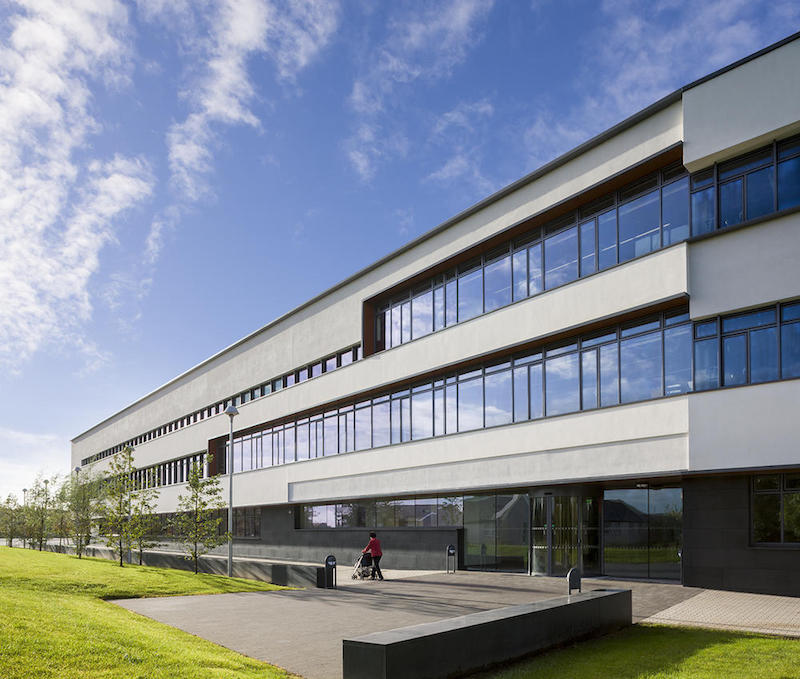 Photo Credit: Payette
Photo Credit: Payette
The design of the BRB embraces the moderate climate of Ireland. By locating low-load spaces along the perimeter of the building, the project is able to take advantage of natural ventilation as the sole conditioning strategy for the majority of the year and is supplemented less than 10% of the year with radiant heating. Due to this approach, 45% of this intensive research building is able to function without mechanical ventilation. This is an extremely simple, yet radical approach and is rarely implemented to even a modest extent in similar laboratories in comparable U.S. climates.
Center for Sustainable Landscapes (CSL); Pittsburgh
The Design Alliance Architects
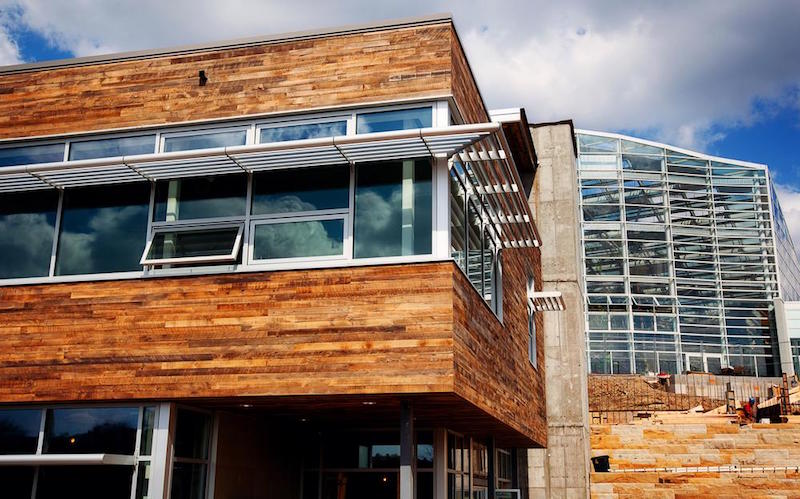 Photo Credit: Denmarsh Photography
Photo Credit: Denmarsh Photography
The CSL is an education, research and administration facility at Phipps Conservatory and Botanical Gardens. Designed to be the greenest building in the world, it generates all of its own energy and treats all storm and sanitary water captured on-site. The CSL is the first and only building to meet four of the highest green certifications: the Living Building Challenge, LEED Platinum, WELL Building Platinum, and Four-Stars Sustainable SITES. As an integral part of the Phipps visitor experience, the CSL focuses attention on the important intersection between the built and natural environments, demonstrating that human and environmental health are inextricably connected.
Exploratorium at Pier 15; San Francisco
EHDD
 Photo Credit: Bruce Delmonte
Photo Credit: Bruce Delmonte
The Exploratorium is an interactive science museum that also demonstrates innovation and sustainability in its design and construction. The building takes advantage of the historic pier shed’s natural lighting and the 800-foot-long roof provided room for a 1.3 megawatt photovoltaic array. The water of the bay is used for cooling and heating. Materials were used that are both sustainable and durable enough to withstand a harsh maritime climate. The project is certified LEED Platinum and is close to reaching its goal of being the country’s largest Net Zero energy museum and an industry model for what is possible in contemporary museums.
H-E-B at Mueller; Austin, TX
Lake|Flato Architects, H-E-B Design + Construction, Selser Schaefer Architects
 Photo Credit: Dror Baldinger, Ray Briggs
Photo Credit: Dror Baldinger, Ray Briggs
H-E-B at Mueller is an 83,587-square-foot LEED Gold and Austin Energy Green Building 4-Stars retail store and fresh food market, including a pharmacy, café, community meeting room, outdoor gathering spaces, and fuel station. It serves 16 neighborhoods and is located in Mueller, a sustainable, mixed-use urban Austin community. Strategies include a collaborative research, goal-setting and design process; integrated chilled water HVAC and refrigeration systems; the first North American supermarket propane refrigeration system; optimized daylighting; 169 kW roof-top solar array; electric vehicle charging; all LED lighting; and reclaimed water use for landscape irrigation, toilets, and cooling tower make-up water.
Jacobs Institute for Design Innovation; Berkeley, CA
Leddy Maytum Stacy Architects
 Photo Credit: LMS Architects
Photo Credit: LMS Architects
Founded on the conviction that design can help address some of society’s most pressing challenges, the Jacobs Institute for Design Innovation at UC Berkeley is devoted to introducing sustainable design innovation at the core of university life. The project provides a new interdisciplinary hub for students and teachers from across the university who work at the intersection of design and technology. It is designed as both a collaborative, project-based educational space and a symbol to the region of the University’s commitment to sustainable innovation, modelling high-density / low-carbon living and learning by reducing energy use 90% below national baseline.
Rene Cazenave Apartments; San Francisco
Leddy Maytum Stacy Architects and Saida + Sullivan Design Partners, Associated Architect
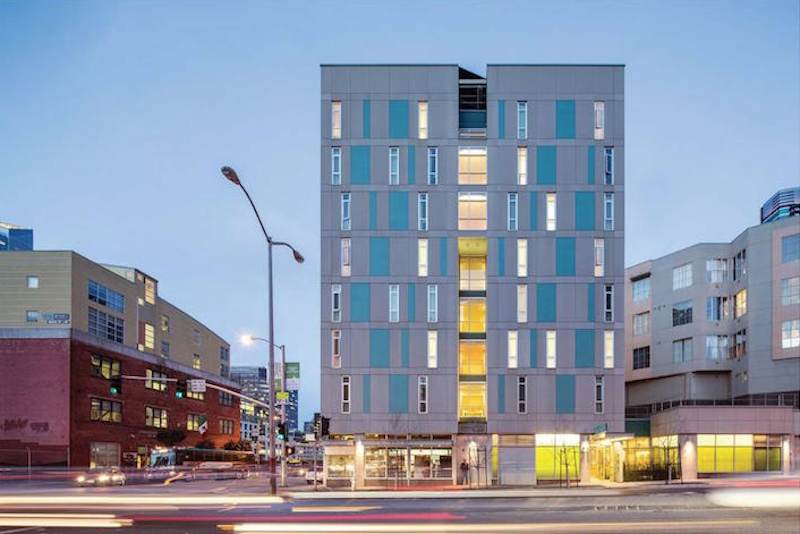 Photo Credit: Tim Griffith
Photo Credit: Tim Griffith
This supportive housing for formerly chronically homeless individuals replaces a former parking lot and freeway off-ramp with a high density, transit oriented, and healthy living alternative. Filtered ventilation, low emitting materials, ample daylight and views combine to aid the residents, many with mental and physical disabilities. Energy costs for the residents and non-profit owner are minimized by a combination of high efficiency lighting and hydronic heating, a continuously insulated rain-screen building envelope and a roof top solar canopy with both hot water and photovoltaic panels. Water is carefully managed by a vegetated roof, smart irrigation, a courtyard storm water tank, and reclaimed water piping.
The Dixon Water Foundation Josey Pavilion; Decatur, TX
Lake|Flato Architects
 Photo Credit: Casey Dunn
Photo Credit: Casey Dunn
The Josey Pavilion is a multi-functional education and meeting center that supports the mission of the Dixon Water Foundation to promote healthy watersheds through sustainable land management. Traditionally livestock has caused more harm than good by overgrazing and not allowing native prairies to play their important role in habitat and watershed protection, and carbon sequestration. As a certified Living Building, the Josey Pavilion facilitates a deeper understanding of how grazing livestock as well as the built environment can work to do more good than harm. Just like the Heritage Live Oak that defines the site, the building tempers the climate and enhances visitor experience by shading the sun, blocking the wind, and providing protected views.
The J. Craig Venter Institute; San Diego
ZGF Architects LLP
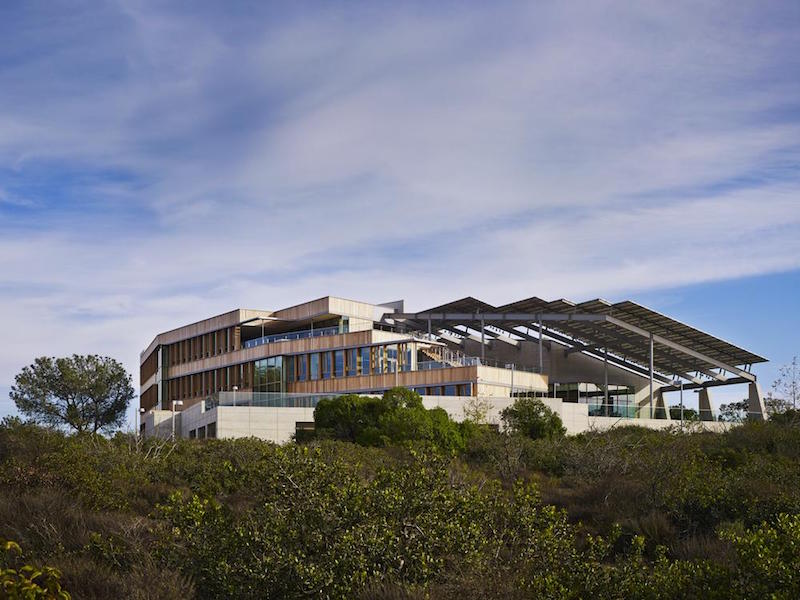 Photo Credit: Nick Merrick
Photo Credit: Nick Merrick
This not-for-profit research institute, dedicated to the advancement of the science of genomics, was in need of a permanent West Coast home. Their commitment to environmental stewardship led to challenging the architects to design a net-zero energy laboratory building, the first in the U.S. The result is a LEED-Platinum certified, 44,607-square-foot building comprised of a wet laboratory wing and an office / dry laboratory wing surrounding a central courtyard, all above a partially below-grade parking structure for 112 cars. The holistic approach to the design revolved around energy performance, water conservation, and sustainable materials.
University of Wyoming - Visual Arts Facility; Laramie, WY
Hacker Architects and Malone Belton Able PC
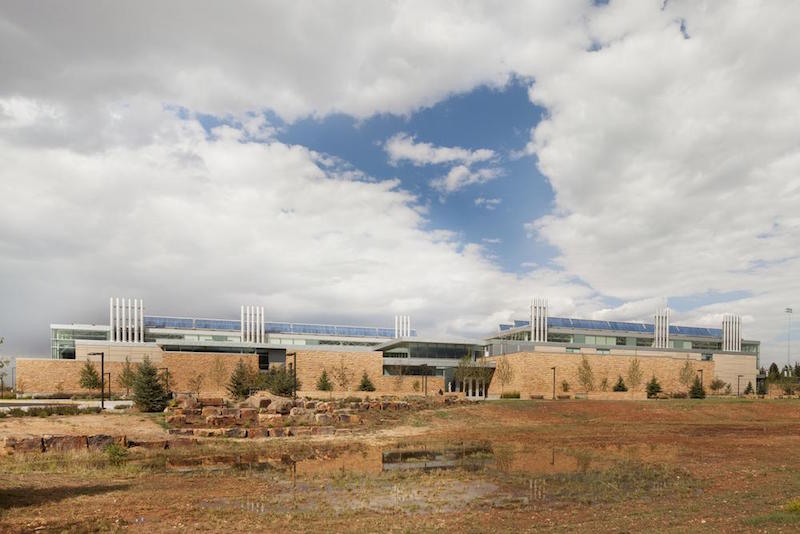 Photo Credit: Lara Swimmer Photography
Photo Credit: Lara Swimmer Photography
The Visual Arts Facility (VAF) consolidates the fine arts program from its scattered locations throughout the campus. The building provides a teaching and learning environment that is both state-of-the-art in occupational safety and in its concern for discharge of pollutants from building. The roof area is fitted with one of the largest solar evacuated tube installations in the U.S. Heat flows from the evacuated tubes to support the hydronic radiant floors, domestic hot water, and pretreat outside air for ventilation. The building was oriented and shaped through a process of studying the sun’s interaction with interior spaces, simultaneously distributing reflected light while eliminating solar gain.
West Branch of the Berkeley Public Library; Berkeley, CA
Harley Ellis Devereaux
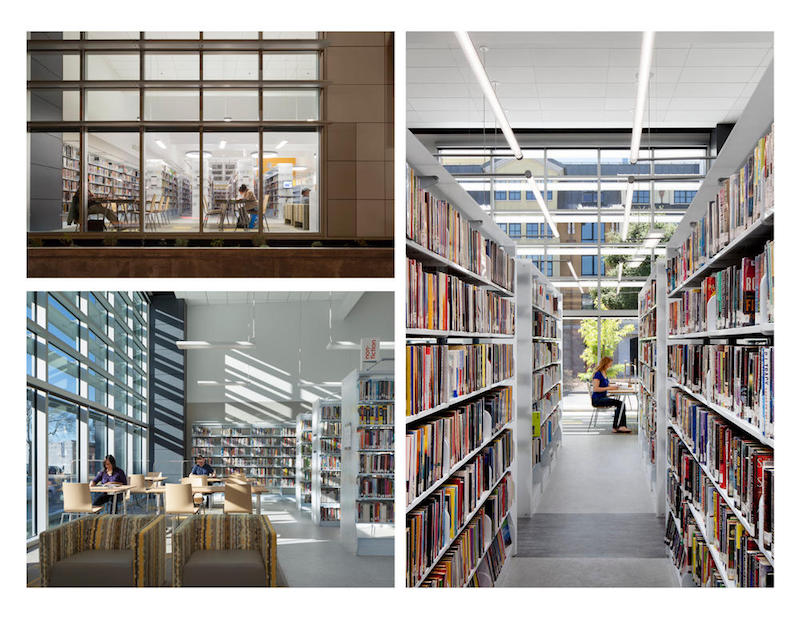 Photo Credit: Wakely and Mark Luthringer
Photo Credit: Wakely and Mark Luthringer
The new 9,500-square-foot West Branch of the Berkeley Public Library is the first certified Living Building Challenge zero net energy public library in California. The building’s energy footprint was minimized through integrated strategies for daylighting (the building is 97% daylit), natural ventilation and a high performance building envelope. An innovative wind chimney provides cross-ventilation while protecting the library interior from street noise. Renewable energy on site includes photovoltaic panels and solar thermal panels for radiant heating and cooling and domestic hot water. The library exceeds the 2030 Challenge and complies with Berkeley’s recently enacted Climate Action Plan.
The 2016 COTE Top Ten Green Projects jury includes:
Larry Strain, FAIA, LEED AP, Siegel & Strain Architects
Luke Leung, PE, LEED Fellow, Skidmore, Owings & Merrill
Judith Heerwagen, PhD, U.S. General Services Administration
Margaret Montgomery, FAIA, LEED AP, NBBJ
Anne Fougeron, FAIA, Fougeron Architecture
Related Stories
Sponsored | Metals | Jul 20, 2015
Life cycle assessment, and why you should care
LCA is a way of quantifying the environmental impact generated by the manufacture and delivery of a product.
Green | Jul 16, 2015
7 parking facilities first to earn Green Garage Certification
The new program rates parking structures based on 48 elements of operation, from water reuse to bicycle parking to car sharing options.
Smart Buildings | Jul 12, 2015
Office of Management and Budget asks agencies to consider climate change when budgeting for construction projects
For the first time, the U.S. Office of Management and Budget is asking agencies to submit budget plans that consider the effects of climate change on construction and maintenance of federal facilities.
Engineers | Jul 12, 2015
White paper explores low-flow toilets’ impact on drain lines, clogs
The research found that certain variables: toilet paper—along with the pipe slope and flush volume—are key variables in determining whether drain lines might be predisposed to clog.
Green | Jul 12, 2015
U.S. Green Building Council aligns programs with CALGreen
California has a new LEED certification path as the state struggles with drought.
Green | Jul 7, 2015
Philips sheds new light on growing fresh food indoors
A research center in The Netherlands is testing the latest techniques in urban farming.
Green | Jun 29, 2015
Rick Fedrizzi to step down as USGBC’s Chief Executive next year
Fedrizzi will be leaving an organization that has grown to 76 chapters. The Washington, D.C.-based USGBC employs 260 people, and last year reported $74.1 million in revenue.
Green | Jun 26, 2015
Training center for electricians in L.A. focuses on net zero technologies
Construction has begun Los Angeles County on what is being called the nation’s largest Net Zero Plus retrofit of a commercial building.
Green | Jun 24, 2015
6 steps toward better water management [AIA course]
When it comes to water conservation, Building Teams tend to concentrate on water-efficient plumbing fixtures, irrigation controls, graywater capture, and ways to recycle condensate from air-conditioning systems. Yet many of the best opportunities for saving water begin with big-picture thinking in a project’s earliest phases.
Green | Jun 19, 2015
3 steps toward sustainable landscape architecture
A water-conscious, sustainable landscape is easily achievable, and the options for native and drought tolerant plants far exceed cacti and succulents, writes LPA's Richard Bienvenu.




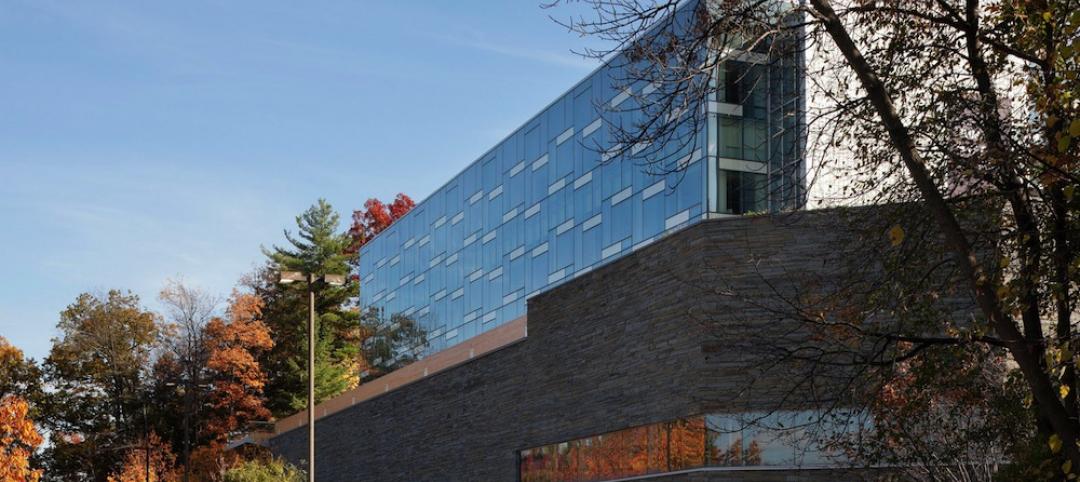





![6 steps toward better water management [AIA course] 6 steps toward better water management [AIA course]](/sites/default/files/styles/list_big/public/VanDusen513.026_grassfix_stairfix.jpg?itok=K8oOWak9)





